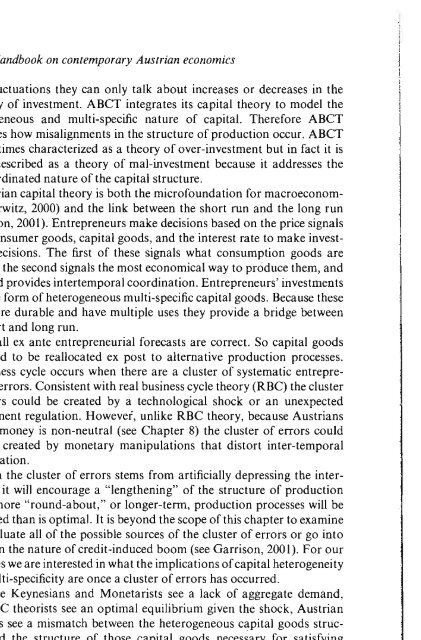Handbook on Contemporary Austrian Economics
Handbook on Contemporary Austrian Economics
Handbook on Contemporary Austrian Economics
Create successful ePaper yourself
Turn your PDF publications into a flip-book with our unique Google optimized e-Paper software.
130 <str<strong>on</strong>g>Handbook</str<strong>on</strong>g> <strong>on</strong> c<strong>on</strong>temporary <strong>Austrian</strong> ec<strong>on</strong>omics<br />
cycle fluctuati<strong>on</strong>s they can <strong>on</strong>ly talk about increases or decreases in the<br />
quantity of investment. ABCT integrates its capital theory to model the<br />
heterogeneous and multi-specific nature of capital. Therefore ABCT<br />
examines how misalignments in the structure of producti<strong>on</strong> occur. ABCT<br />
is sometimes characterized as a theory of over-investment but in fact it is<br />
better described as a theory of mal-investment because it addresses the<br />
dis-coordinated nature of the capital structure.<br />
<strong>Austrian</strong> capital theory is both the microfoundati<strong>on</strong> for macroec<strong>on</strong>omics<br />
(Horwitz, 2000) and the link between the short run and the l<strong>on</strong>g run<br />
(Garris<strong>on</strong>, 2001). Entrepreneurs make decisi<strong>on</strong>s based <strong>on</strong> the price signals<br />
from c<strong>on</strong>sumer goods, capital goods, and the interest rate to make investment<br />
decisi<strong>on</strong>s. The first of these signals what c<strong>on</strong>sumpti<strong>on</strong> goods are<br />
desired, the sec<strong>on</strong>d signals the most ec<strong>on</strong>omical way to produce them, and<br />
the third provides intertemporal coordinati<strong>on</strong>. Entrepreneurs' investments<br />
take the form of heterogeneous multi-specific capital goods. Because these<br />
goods are durable and have multiple uses they provide a bridge between<br />
the short and l<strong>on</strong>g run.<br />
Not all ex ante entrepreneurial forecasts are correct. So capital goods<br />
will need to be reallocated ex post to alternative producti<strong>on</strong> processes.<br />
A business cycle occurs when there are a cluster of systematic entrepreneurial<br />
errors. C<strong>on</strong>sistent with real business cycle theory (RBC) the cluster<br />
of errors could be created by a technological shock or an unexpected<br />
government regulati<strong>on</strong>. However, unlike RBC theory, because <strong>Austrian</strong>s<br />
believe m<strong>on</strong>ey is n<strong>on</strong>-neutral (see Chapter 8) the cluster of errors could<br />
also be created by m<strong>on</strong>etary manipUlati<strong>on</strong>s that distort inter-temporal<br />
coordinati<strong>on</strong>.<br />
When the cluster of errors stems from artificially depressing the interest<br />
rate it will encourage a "lengthening" of the structure of producti<strong>on</strong><br />
where more "round-about," or l<strong>on</strong>ger-term, producti<strong>on</strong> processes will be<br />
employed than is optimal. It is bey<strong>on</strong>d the scope of this chapter to examine<br />
and evaluate all of the possible sources of the cluster of errors or go into<br />
depth <strong>on</strong> the nature of credit-induced boom (see Garris<strong>on</strong>, 2001). For our<br />
purposes we are interested in what the implicati<strong>on</strong>s of capital heterogeneity<br />
and multi-specificity are <strong>on</strong>ce a cluster of errors has occurred.<br />
Where Keynesians and M<strong>on</strong>etarists see a lack of aggregate demand,<br />
and RBC theorists see an optimal equilibrium given the shock, <strong>Austrian</strong><br />
theorists see a mismatch between the heterogeneous capital goods structure<br />
and the structure of those capital goods necessary for satisfying<br />
c<strong>on</strong>sumer desires. There is no lack of aggregate demand; there is a lack of<br />
enough particular demand for the c<strong>on</strong>sumer goods produced by the existing<br />
combinati<strong>on</strong>s of capital goods. To recover from a depressi<strong>on</strong> <strong>Austrian</strong><br />
theory shows bad investments must be liquidated and capital reallocated.

















